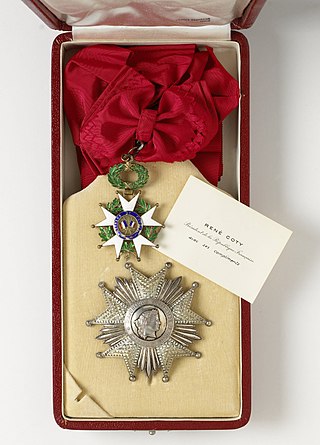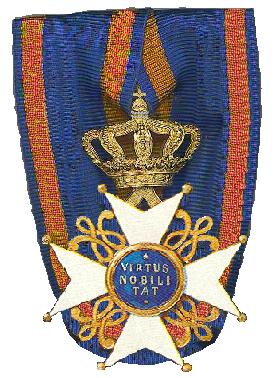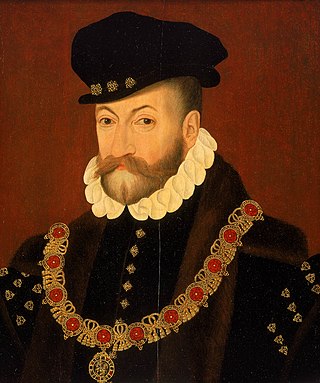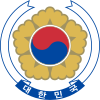
Roh Tae-woo was a South Korean army general and politician who served as the 6th president of South Korea from 1988 to 1993. He was the first democratically elected president of South Korea.

The National Order of the Legion of Honour, formerly the Imperial Order of the Legion of Honour, is the highest French order of merit, both military and civil, and currently comprises five classes. Established in 1802 by Napoleon Bonaparte, it has been retained by all later French governments and regimes.

The Order of Merit of the Federal Republic of Germany is the only federal decoration of Germany. It is awarded for special achievements in political, economic, cultural, intellectual or honorary fields. It was created by the first President of the Federal Republic of Germany, Theodor Heuss, on 7 September 1951. Colloquially, the decorations of the different classes of the Order are also known as the Federal Cross of Merit.

Yun Po-sun was a South Korean politician and activist who served as the second president of South Korea from 1960 to 1962. He was the only president of the short-lived Second Republic of Korea, and served as little more than a figurehead due to its nature as a parliamentary system.

The Order of Leopold is one of the three current Belgian national honorary orders of knighthood. It is the oldest and highest order of Belgium and is named in honour of its founder, King Leopold I. It consists of a military, a maritime and a civil division. The maritime division is only awarded to personnel of the merchant navy, and the military division to military personnel. The decoration was established on 11 July 1832 and is awarded by Royal decree.

The Order of Orange-Nassau is a civil and military Dutch order of chivalry founded on 4 April 1892 by the queen regent, Emma of the Netherlands.

The Order of the White Lion is the highest order of the Czech Republic. It continues a Czechoslovak order of the same name created in 1922 as an award for foreigners. It was inspired by the Czech Nobility Cross created in 1814 by the Emperor and King Francis II and awarded to 37 Bohemian noblemen.

The Order of the Netherlands Lion, also known as the Order of the Lion of the Netherlands is a Dutch order of chivalry founded by William I of the Netherlands on 29 September 1815.

The Royal Norwegian Order of Saint Olav is a Norwegian order of chivalry instituted by King Oscar I on 21 August 1847. It is named after King Olav II, known to posterity as St. Olav.

The Nishan-e-Imtiaz is one of the state organized civil decorations of Pakistan. It is awarded for achievements towards world recognition for Pakistan or outstanding service for the country. However, the award is not limited to citizens of Pakistan and, while it is a civilian award, it can also be awarded to military personnel and worn on the uniform. Nishan, translating as decoration/order/mark, is a highly restricted and prestigious award, roughly equivalent to Presidential Medal of Freedom and Order of the British Empire, and is the first category award of Order of Imtiaz. The other three descending categories are Hilal-i-Imtiaz, Sitara-i-Imtiaz and Tamgha-e-Imtiaz. Usually, it is regarded as the highest award one can achieve in Pakistan since the higher award Nishan-e-Pakistan is awarded only to foreign Heads of States.

A livery collar or chain of office is a collar or heavy chain, usually of gold, worn as insignia of office or a mark of fealty or other association in Europe from the Middle Ages onwards.

The Order of the Nile was established in 1915 and was one of the Kingdom of Egypt's principal orders until the monarchy was abolished in 1953. It was then reconstituted as the Republic of Egypt's highest state honor.

A collar, also known as collar of an order, is an ornate chain, often made of gold and enamel, and set with precious stones, which is worn about the neck as a symbol of membership in various chivalric orders. It is a particular form of the livery collar, the grandest form of the widespread phenomenon of livery in the Middle Ages and Early Modern Period. Orders which have several grades often reserve the collar for the highest grade. The links of the chain are usually composed of symbols of the order, and the badge of the order normally hangs down in front. Sometimes the badge is referred to by what is depicted on it; for instance, the badge that hangs from the chain of the Order of the Garter is referred to as "the George".

Roh Moo-hyun was a South Korean politician and lawyer who served as the ninth president of South Korea between 2003 and 2008.

The Honorary Order of the Yellow Star is the highest state decoration of the Republic of Suriname. The Order was instituted in 1975 at the independence of Suriname and replaced the Dutch Order of the Netherlands Lion. It is awarded to individuals for their meritorious service to the Surinamese people or nation. Foreigners are also eligible to receive the order. The president of Suriname is the Grand Master of the order.

Kim Young-sam, often referred to by his initials YS, was a South Korean politician and activist who served as the 7th president of South Korea from 1993 to 1998.
The South Korean honors system includes orders of merit, medals of honor, and commendations conferred by the South Korean government onto its citizens and foreigners.

Chun Doo-hwan was a South Korean politician, army general and military dictator who served as the fifth president of South Korea from 1980 to 1988.
The Order of Sultan Sharafuddin Idris Shah is an order awarded by Sultan of Selangor as a reward for general services to the sultan and state of Selangor. It was founded on 14 December 2002 to replace the abolished Order of Sultan Salahuddin Abdul Aziz Shah. The order is awarded to high-ranking individuals who have contributed excellence to the Sultan of Selangor and His Majesty's Government.
The Order of the Leopard is a merit order of the former Republic of Bophuthatswana. The Order was instituted in order to recognise service to the people of the Republic of Bophuthatswana. It was instituted by the President of the Republic of Bophuthatswana by official Warrant on 28 December 1979.


















